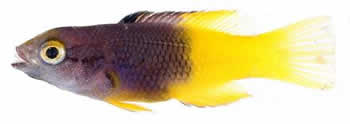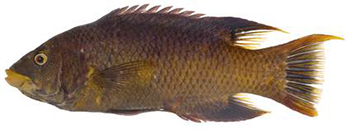Spanish Hogfish
Bodianus rufus


Taxonomy
Common Name(s): Spanish Hogfish (or Dogfish, Hogfish, Hog Snapper)
Kingdom: Animalia
Phylum: Chordata (Vertebrata)
Class: Actinopterygii
Order: Perciformes
Family: Labridae (Wrasses)
Genus: Bodianus
Species: rufus
Habitat / Distribution
The Spanish Hogfish inhabits many tropical waters (22°C – 28°C), occupying a great range from Bermuda and Southern Florida all the way down to Southern Brazil.(6) While B. rufus has a large range in the Atlantic, it’s distribution within a particular locality is extremely patchy. The patchiness of B. rufus’ distribution makes it difficult to estimate to total population size.(6)
B. rufus are known to live both along the coast and offshore and like to make coral reefs and generally rocky habitats their homes.(4) The areas of reef most rich in Gorgonians, like sea whips and sea fans, are areas with higher probability of a close encounter with B. rufus.(1) But, these fish can also be caught living in sea grass meadows and reefs covered with algal growth.(6)
According to Lieske and Myer’s 1994 Pocket Guide to Coral Reef Fishes, B. rufus can be found anywhere from 1 meter to 60 meters deep. The juveniles are most closely associated with coral reefs in shallow tropical waters, especially large coral heads, where they act as cleaners.
Diet
Spanish Hogfish are facultative cleaners, meaning they act as cleaners during the juvenile portion of their life cycle, but switch to another diet as adults. The juvenile’s diet is a feast of dead tissues, parasites, excess mucus and more from the bodies of their clientele.(1)(3)(6)
As adults, they switch to a diet of marine invertebrates, namely brittle stars, mollusks, crustaceans, and sea urchins.(6) Hogfish use their strong jaws and anterior canine teeth to crush the hard shells of their prey.(1)
Hogfish get their name from they way they stick their elongated, snout-like mouth into the sand to root around for prey, in much the same way as a pig.(1)
Appearance & Behavior
The body of the Spanish Hogfish is laterally compressed. The shape is elongate with a snout that is relatively large.(3)(4) Their eyes are a golden color. The anterior most section of the dorsal fin is serrated. B. rufus has 17-19 gill-rakers, distinguishing it from closely related Bodianus spp.(4)
There is no notable sexual dimorphism. The coloring of the juveniles differs from that of the adults, but the changes are not extremely sudden. Juveniles have a bright purplish/bluish forebody and bright yellow stomach and tail. As the fish matures the purplish color recedes, becoming most intense dorsally and anteriorly.(3) Those individuals found in deeper waters appear more mottled in color (no clear separation between purplish and yellow regions) and can be reddish.
They are a diurnal species, meaning they are active during the daytime. Juveniles are constantly swimming around the reef picking parasites off of bigger fishes and adults root around in the sediment for crustaceans, mollusks and echinoderms.
Reproduction / Life Cycle
The Spanish Hogfish is a protogynous (female-first) hermaphrodite.(1) Females can undergo transformation to become a sexually active male. B. rufus live together in harems, with 1 dominant male that guards and mates with around 12 females.(5)(6) While 12 is the most common number of females living in a harem, the actual number can vary from 3 to 20 females. When the single male dies or is otherwise removed from a harem, only 1 female, typically the largest and most dominant female, is able to change her sex.(5) This process is incredibly fast, the average time of the sex conversion being successfully completed around an average of 5.6 days.(5)
The male that guards the harem has sole reproductive access to all of the females within the harem. So, in a large harem, the largest female could be potentially increasing her reproductive success by transforming into the male of the group. This species are oviparous, the eggs undergo very little development within the mother. Fertilization is external and occurs all year long, typically in the late afternoon.(5) The females only mate with the male that defends her harem. After he courts her, they both rush up to surface to spawn (referred to as a “spawning rise”), releasing their eggs and sperm into the open water where they will come together and fertilize.(1)(5) These pelagic zygotes are on their now on their own, Spanish Hogfish don’t exhibit parental care of any kind.(5)
The Spanish Hogfish eggs are pelagic, floating around in the water column. Development is rapid, with larvae hatching within 24 hours of fertilization.(1) Larvae grow into juveniles over several weeks and will eventually settle out of the water column after they find a suitable habitat in which to make a living.(1) While other members of the Labridae family burrow in the sand below, B. rufus larvae settle on the reef itself.(6)
It may be possible for B. rufus to hybridize with the Spotfin Hogfish (B. pulchellus).(6) These two species are indistinguishable without counting the number of gill rakers, which is 17-19 in B. rufus and 15-16 in B. pulchellus.(4)
Economic / Ecological Service
B. rufus plays a relatively minor role in the aquarium trade compared to other, more glamorous tropical fish, but many thousands are exported from Brazil every year (3,177 in 2007).(6) Regardless, there is no record that this leads to population decreases or range restrictions.
However, this does not mean that human activities are not affecting the species in some way. Two-thirds of the reefs that these fish inhabit are in danger “thanks to anthropogenic factors”.(6) No one really knows exactly how dependent this species is on the coral reefs, but since the juveniles are so closely associated with the reef habitat destruction of the reefs could be detrimental to the species.
B. rufus has no major predators in the wild, but it occasionally finds itself in the stomach of bottlenose dolphins in Florida or larger bony fish and sharks.(1)(6)
Although I found no instances of Bodianus rufus in particular being utilized as a food source, other species of Hogfish are a source of both fresh and frozen fish for humans. And, consumption of Hogfish has been associated with ciguatera poisoning.(1) Ciguatera poisoning is contracted by eating fish that are contaminated with dinoflagellate produced toxins.
Recent Research
Other than descriptive studies I didn’t find too much current recent research going on with this species.
In the 1980s the Spanish Hogfish was involved in an experiment examining the size-advantage hypothesis and the costs associated with hermaphroditism (Hoffman, et al., 1985). The size-advantage hypothesis proposes that if a sex change can significantly increase an individual’s reproductive success after it reaches a certain size, then making the change would be advantageous to that individual. If a male of a certain size has sole mating access to an entire harem, then a female that transforms into a male can greatly increase her reproductive success (passing her genes on anywhere from 3 to 20 times more than she otherwise would had she remained female). In this study, female Spanish Hogfish were observed to suffer little in the way of reproductive costs when they change sex. Even though it takes a lot of resources to change your sex, the speed at which they are able to transform to males and successfully spawn with all of the females in their harem makes up for costs. A newly transformed male can mate with all of the females in their harem within a week after sex change, increasing reproductive success.
More recently, Spanish Hogfish juveniles were involved in a study observing cleaning behavior (Coni, et al., 2010). The cleaning behavior is one of the most important interspecific behaviors that occurs between reef fish.(5) Because Spanish Hogfish are diurnal, most of their clients are also diurnal, but it has also been observed to clean some nocturnal species.(5) The dens of cleaners and clients tend to be located fairly close together, probably to reduce the chances of attack by predators.(5) The mutualism is important to B. rufus juveniles as a food source and their clients as a way to rid themselves of pesky parasites.
Personal Interest
I chose the Spanish Hogfish because I had never heard of it before and wanted to learn more about it. Also, I just liked their coloration and I thought the juveniles were cute.
Literature Cited
Please note that the following references may have either been removed or relocated by the webpage owners since the time this student report was created.
- Bester, Cathleen. Hogfish. In: Florida Museum of Natural History Ichthyology. <http://www.flmnh.ufl.edu/fish/Gallery/descript/hogfish/hogfish.html>. 30 May 2013.
- Coni, E.O.C., Nunes, J.A.C.C., Ferreira, C.M., Maia-Nogueira, R., Medeiros, D.V., and Sampaio, C.L.S. “The Spanish hogfish Bodianus rufus (Labridae) acting as cleaner of nocturnal fish in the north-east of Brazil” Marine Biodiversity Records. Volume 3. e23(2010): Online. 30 May 2013.
- de Kluijver, M., et al. Spanish hogfish (Bodianus rufus). In: Marine Species Identification Portal. <http://species-identification.org/species.php?species_group=caribbean_diving_guide&id=253&menuentry=soorten>30. May 2013.
- Freddern, H. A. “Color Pattern Changes During Growth of Bodianus Pulchellus and B. Rufus (Pisces: Labridae)” Bulletin of Marine Science. Volume 13. 2(1963): 224-241(18).
- Hoffman, S.G., Schildhauer, M.P., Warner, R.R. “The Costs of Changing Sex and the Ontogeny of Males Under Contest Competition for Mates” Evolution. Volume 39. 4(1985): 915-927.
- Xie, Y. & Russell, B. 2010. Bodianus rufus. In: IUCN 2012. IUCN Red List of Threatened Species. Version 2012.2.< www.iucnredlist.org>. Downloaded on 30 May 2013.
Links
Please note that the following links may have either been removed or relocated by the webpage owners since the time this student report was created.
The IUCN Red List of Threatened Species
http://www.iucnredlist.org/details/summary/187672/0
Ocean Footage
http://www.oceanfootage.com/oceans/search?screen=search&within=1&savesearch=1&keywords=spanish+hogfish
YouTube
http://www.youtube.com/results?search_query=spanish+hogfish&oq=spanish+hogfish&gs_l=youtube.3..0.1424.3471.0.3704.15.9.0.6.6.0.189.840.7j2.9.0...0.0...1ac.1.11.youtube.AigSyX0l-nc
Encyclopedia of Life
http://eol.org/pages/212988/details
Fish Base
http://fishbase.org/Summary/speciesSummary.php?ID=1067&AT=spanish+hogfish
Marine Bio
http://marinebio.org/species.asp?id=942